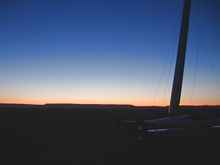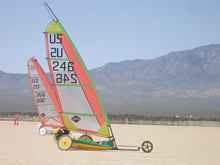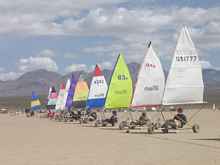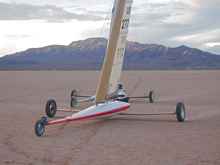
 Custom Search
|
|
| sails |
| plans |
| epoxy |
| rope/line |
| hardware |
| canoe/Kayak |
| sailmaking |
| materials |
| models |
| media |
| tools |
| gear |
 |
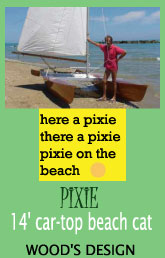 |
| join |
| home |
| indexes |
| classifieds |
| calendar |
| archives |
| about |
| links |
| Join Duckworks Get free newsletter Comment on articles CLICK HERE |
|
|
| Rockin' the Playa |
by Dave Farmer - Tum Tum, Washington - USA |
Oh yes! It's the America's Cup of Landsailing time again! The glorious gathering of seriously deranged wind addicts. Like myself. I roll onto the playa Friday evening, just in time to crack a brew and hang with my buddies til the sky fills with stars. Sunrise stirs the camp, and I assemble the big boat. By the time she's together, wind shows, right on time! Yippeee, I'm landsailing again! Today's the tune up day, so I share the lakebed with the brethren, coverin' ground, occasionally returning to the pits for adjustments. A good day under wind power, and we're ready to race.
Sunday delivers the goods, the conditions I dream of all year. I arise to 20 kts out of the southwest, and when it warms up enough, I rig the Fed 5 with the 4 meter sail. Already overpowered, it's a game of maintaining control, white knuckles on the hand steering to augment and stabilize the foot steering. The gps is immediately registering 50mph plus, and in this tiny craft, great precision is required to keep her on course. The trick is to just touch the edge of the power window, which when done right, produces the exhilarating acceleration that I've come for. Hit it too hard, and the windward wheel leaps skyward, demanding an instant steering correction, or a last ditch sheet dump. Or the rear end breaks loose, threatening a spin. Attention, focus! By afternoon the windspeed has climbed into 30s, and I'm now sporting "The Handkerchief", my 2.5 meter sail, and still I'm hugely overpowered. I can now consistently see speeds in the high 50s and mid 60s on the downwind legs, and the adrenaline is flowing like wine! By sunset I've recorded a top speed of 70.2 mph, a new record for my little boat, and the log says I've covered 143 miles of lakebed. A satisfying (and exhausting!) day all round, and I retire with that grin I've become so fond of. Now, for the most part, we landsailors are an aging demographic, an affliction affecting all of sailing, if not most outdoor activities. So we were thrilled to have young Brandon Frost pull up to the starting line in his Class III big boat. He and his Dad have spent a lot of weekends on their local dry lake beds around SoCal over the last few years, and as a result, he knows how to get her up rolling and keep her there. All those hours at speed translate into a podium finish for Brandon, and his promise to return again next year.
I'm still a racing novice, my forte is generating speed, taking whatever craft I'm piloting right to the edge of control, given enough breeze to power her up. But that's only one arrow in the racer's quiver. There's tactics, making decisions to optimize one's positions relative to the other competitors. And the ability to keep the machine rolling in light air. Skilled dirt boaters have developed the ability to 'see' the wind as it scours the playa, interpreting the mirages for clues to the wind strength and direction, so that one makes the best choices to stay in the pressure. All skills I'm developing slowly. It's hard to imagine that I can ever compete with some of these guys and gals that have been doin' it for decades. But it's sure fun to try! We've got 5 basic classes, with races run in rotation. Once we've completed a round of all five, we start again at the top of the order, til we run out of time or wind. 15 or 20 minute races, a windward leeward course. Like all sail racing, the action is most intense at the marks. At the windward mark, the bear away to a downwind course brings the boats broadside to the wind, and if there's enough wind strength to threaten capsize, the skipper needs to fully commit to the turn. The windward wheel hikes sharply, and only a smooth, quick, firm turn downwind can bring it down gently. The boat accelerates fiercely. At the leeward mark, we're approaching with maximum speed, and now the trick is to carve a wide enough arc to maintain velocity, and minimize the speed sucking drift if the tires lose traction. Enter too hot, and turn too sharply, and you run the risk of busting the rear end loose entirely, and enter a spin, causing your fellow sailors to scatter madly! The Fed 5 runs in a strong, fairly evenly matched class. I also have this magnificent machine, Johnny's Rocket, that competes with the big boats. These rides are the pinnacle of landsailing technology, with sophisticated solid wings and wingmast/sail rigs, mated to streamlined fuselages riding on supple suspensions. When fully juiced, the feeling of power is stunning! Tires clawing at the lakebed, desperately trying to transfer all that horsepower into forward motion. When a gust hits with the boat already at speed, she leaps forward, easily accelerating an additional 10 mph in a matter of boatlengths, simultaneously skittering sideways as the pilot responds with rapid and minute steering corrections to maintain course. The rush is delicious! The Rocket is artfully constructed out of wood by a fine cabinet maker, state of the art ten years ago, and a class winner. Now the top runners are carbon or aluminum creations, at a fraction of my weight, and therefore superior in the light stuff. Not to mention that they're in the hands of men who've been practicing this art for many years. But chasing them around the course is still good fun, and I'm slowly gleaning knowledge as I follow in their wake. Now the America's Cup of Landsailing is not just about dirt boating, no. This is one fine group of folks to hang out with. Gregarious, generous, and certainly humorous. We have meetings after the racing to elucidate the standings, praise the praiseworthy, and ridicule the deserving (often me!). Various clubs provide evening meals for the whole contingent in the big tent, accompanied by appropriate libations. The SASSASS group from Santa Cruz once again fired up the Sassinator, a hardly modified, gas powered cement mixer capable of producing 10 gallon batches of mai tais or margueritas, whichever the meal calls for. The sun sets, and one can wander from camp to camp, searching out the best conversation, while gazing up at the desert stars. Racing commences in earnest on Monday, and the esteemed race committee reels off six rounds of races in 3 days. The sometimes challenging conditions would offer up plenty of power to get the fleet up to speed, only to shut off completely, scattering the boats as they search franticly for the slightest pressure to keep up precious momentum. The skilled can expertly maintain speed til the wind filled back in, and those of us less experienced pilots often grind to a halt, and then jump out to push off in some hopeful direction. A number of midwest DN iceboat sailors show up for a taste of dirt, and quickly prove that ice sailing skills transfer well to desert racing. Jim Gleuk from Wisconsin takes home the trophy for Class V, and places second to his brother Dave in the FISLY 5 class. Not bad for his first time landsailing, in borrowed boats! I manage third place, well behind them both, and mid pack in Class III. We wrap things up Friday noon with the awards ceremony, and we file out of the tent to pack up and meander homeward. A successful event with great racing, fine companionship, a few new converts, and a bunch of smiles to last us til next March. Thankyou Race Committee! |
